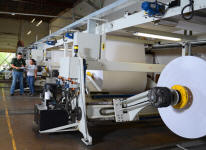|
|
SPLICE DETECTOR™ TECHNOLOGIES
WELCOMES YOU TO OUR SITE |
|
|
|
|
In the early 1950's Canada and the United States saw a dramatic increase in immigration from many European countries. Although there are no known statistics on the subject, there is plenty of evidence that many of these immigrants accounted for a very large percentage of the high-tech companies that were launched during the last sixty years. In particular, Ottawa Canada became a hub of ingenuity and technological innovation. Telecommunication innovations in particular saw a rich tapestry of optoelectronic components developers and equipment suppliers spun from their early threads. One of the first notable optoelectronic companies created during the 1950's was Nash and Harrison founded by a British Hungarian immigrant. Dedicating their R&D to web based material manufacturers like paper makers, textiles, steel and other materials, Nash & Harrison invented, designed, patented and implemented various web inspection, quality assurance and control technologies, many still in use today. Other notable companies founded shortly afterwards were EDA Electronics, R&D giants Bell Northern Research (not Nortel Networks) and Computing Devices of Canada (now General Dynamics). During the 1960's in particular, many of these founding power houses of technological innovation saw many spin-offs created either directly by immigrant employee innovation or through partnerships with Government and Educational laboratories. Most notable were Mitel, JDS, Leigh Instruments launched in 1960 and Lumonics.
One of the most important optoelectronic innovations developed in the late 1950's and patented and launched in the 1960's was the Splice and Tearout Detection System from Nash & Harrison Ltd. Developed to provide converting companies and web based material manufacturers with the ability to sense splices (joints) and tearouts at speed, this earlier system delivered high quality detection with very minimal operational intervention. The earlier splice detector technology solutions were designed for use on paper cutters, sheeters, slitters and winders where it was imperative to detect splice and tearouts prior to roll shipment. Since many application were in the area of printing and packaging, web based manufacturers faced tens of thousands of dollars in complaints per year should splices get by and cause both esthetically and mechanical damage in subsequent material processes.
Today, with the advent of online splicing and the use of coating finishes on many products we purchase today, it is more imperative that splices, tearouts and other significant changes in web based material be detected at speed. Today, converters especially, are confronted with roll material where more than one splice per roll is not uncommon. Additionally, and for various reasons, pieces of material can be torn from edges commonly referred as "Tearouts". Over the last couple decades, the art of splicing has evolved to include "butt splices" (mill splices), "overlap splices" and "on the fly splices (tail splices). Due to environmental concerns and material costs, newer recyclable splice tapes are used that can go undetected by older technologies like phototransistor, laser and ultrasonic. The existence of splices or other defects like tearouts in rolls of material is not a great problem as long as their whereabouts are known; however, they are difficult to locate when the material is in roll form, unless such defective areas are clearly flagged which is few and far between.
In finishing processes, it is quite common to cut these rolls of material in to sheets. Today, many sheeter manufacturers offer systems capable of cutting up to 10 or more rolls at one given time. In some cases, these sheets are sold to converting companies that provide sheet fed printing for advertising, labeling, etc. Other products are sheeted and packaged for our daily use such as copy paper or writing papers. Today with modern advancement, many converters have moved into web fed processes where their production runs 24/7. Even with constant vigilance, splices and tearouts are not usually visible to production personnel. Should these defects remain undetected in single or multi web fed processes, such defects can and do cause significant downtime and repairs to printing equipment, coating equipment and other sensitive production components. Obviously today, hiring personnel to manually sort or watch for such occurrences is time consuming, expensive and unproductive.
Through ongoing development, the basic methodology, patented in 1970 has provided thousands of customers worldwide with stable, accurate and consistent splice detection without the need for operational intervention, adjustments or re-calibration. Today our splice detection technology can monitor multi webs of material. The material being monitored is treated as a dielectric and as such, changes in this dielectric value caused by sudden changes in total web thickness of a given number of webs resulting from a splice or tear out. Long term variances in dielectrics due to changes in number of webs, material caliper, type or color does not affect the operation. Our splice detection technology, unlike photo-eyes, ultrasonic and knock offs of our original design, our technology does not require pre-run setups, special splice markings or adjustments. Our technology is completely self calibrating to and will operate at speeds well in excess of those used in paper, coating and conversion processes. Exact edge control is not required. While it may cost you less to try cheap alternatives or knock offs, our splice detection technology can guarantee detection the first time and every time no matter what grade or material you are running. Don't jeopardize your customer base by wasting time with ineffective technologies, get our splice detector working for you today and build your customer base.
Many of our employees have been with us for more than 25 years with key personnel celebrating more than 30 years. Our technological expertise coupled with our leading market position and support disciplines provide all of our customers with leading edge technology that is unsurpassed in performance. Since we rely on openness and cooperation unlike other suppliers, we can offer our customers the ability and flexibility to customize there inspection solutions to meet their quality assurance initiatives. This allows us to become an integral part and valuable link in the overall process of web based material manufacturing. In addition to our Corporate Headquarters in New York, we have offices located worldwide through partnerships with leading technological companies in Europe, South America, Africa and Asia.
Please take some time to review our website. If there are any products that may interest you, please feel free to use our submission inquiry form and we will forward the appropriate information to you. Should you have an application that requires addressing immediately, please feel free to call us direct or one of our offices or agencies located in your area of the world. We thank you for visiting us and look forward to working with you as your quality assurance and control partner.
|
||
Home | Products | Download Center | History | News | Jobs | Contact | Links | Feedback
|
|||
|
Information provided herein protected - © Copyright
2006-2019 Splice Detector™ Technologies
|
|||

